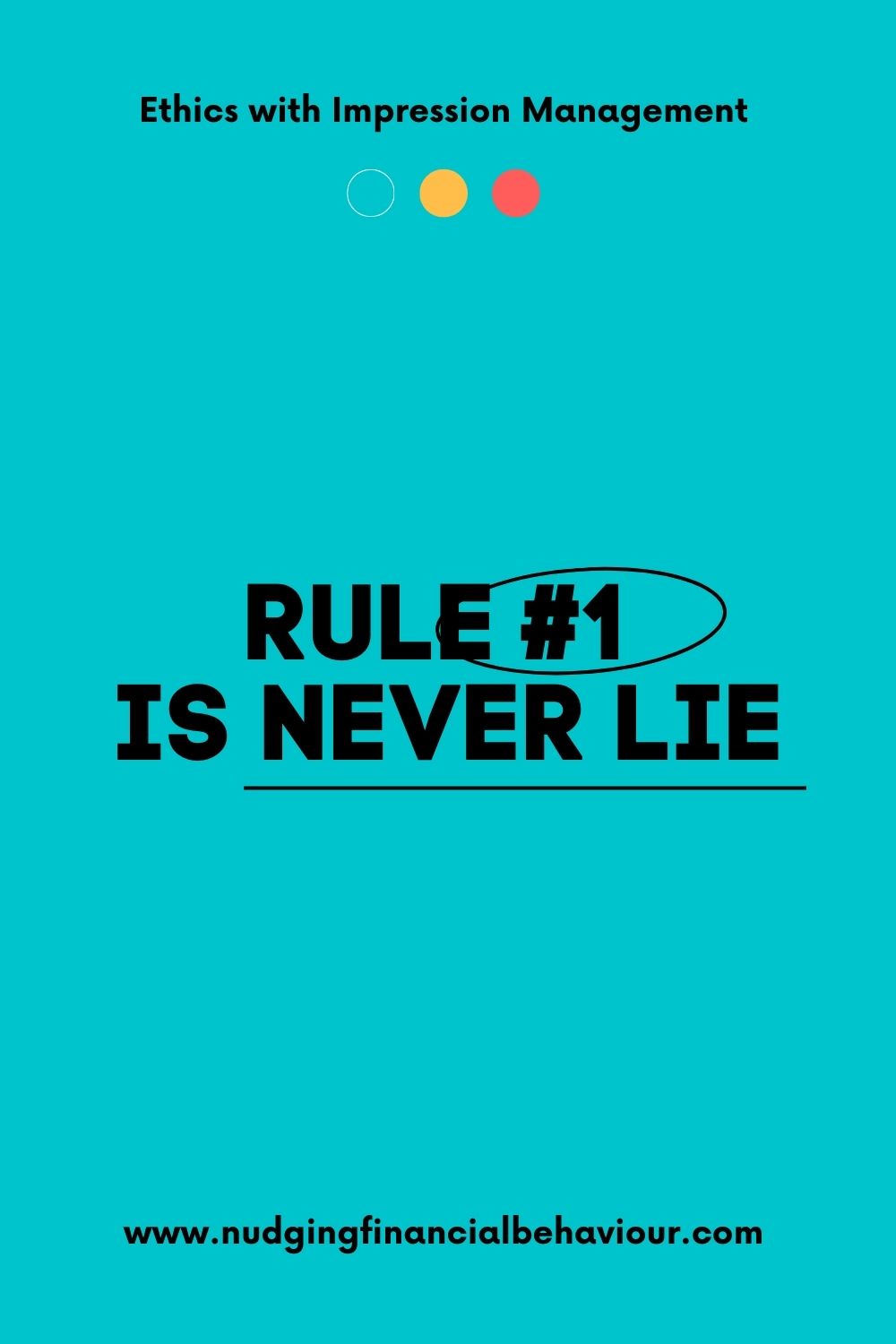In the realm of risk and loss aversion, understanding the nuances of impression management techniques becomes paramount. In this final instalment of our little mini-series, we investigate the fascinating field of impression management, exploring how it shapes our perceptions and influences decision-making.
We’ve also enlisted the expertise of Candice Burgess-Look, a seasoned PR specialist, to guide us through the intricacies of managing impressions effectively and how to be more vigilant consumers.
Listen to the podcast on your preferred streaming platform. Or click the link below to watch it on our YouTube channel.
Impression management, as the name suggests, revolves around shaping the perception others have of us or the information we present. Whether it’s corporate earnings report or personal interactions, the goal remains consistent: to cast a favourable light on the subject at hand.
Essentially, impression management uses subtleties to make you ‘feel better’ about the information you’re being presented with. Share on XThere are many ways this is done. In financial reports, we often see impression management tactics such as overloading you with information, using symbols rather than words, and applying the principles of prospect theory.
Remember that prospect theory showed us how we value losses more than gains. Because the S curve is steeper with losses (or bad news), the principle is that you give all the bad news at once. Rip that Band-Aid off and get it all over and done with. Whereas gains (or good news) you rather give incrementally. Basically, you want to milk the good stuff. Each time you bring in some more good news, you’re maximising that positive utility.
The basic theory is, if you have bad news, give it all in one go. And if you have good news, drip feed it. Share on XImpression management is not something new. Human beings have been doing this since we could communicate with each other. We all want to put our best foot forward. As Niccolo Machiavelli astutely noted centuries ago, the art lies in strategically timing the release of information, leveraging our innate tendencies towards loss aversion to maximise impact.
Let’s consider how a smart CEO, aware of behavioural finance principles, can use this particular bias to create a good morale in the office, despite some bad news…
The reality is that the business is struggling. So, the CEO gathers everyone for a meeting and delivers the bad news… due to financial challenges, the company is implementing significant cost-cutting strategies, including freezing salaries and reducing benefits.
Now, as the meeting progresses, the CEO reveals that the company will provide additional presentation training and skills development programs to enhance employees’ expertise, ensuring they remain competitive in the professional job market despite the freeze in salaries.
Next, the CEO announces the company will introduce flexible work hours and remote work options, allowing employees to achieve a better work-life balance. Really dragging out the good news, bit by bit…
Finally, the CEO unveils a new team recognition program where outstanding performance will be rewarded with bonuses, acknowledging leadership and appreciating employees’ hard work and dedication.

The truth is rarely pure and never simple.
In this scenario, the bad news is presented all at once. Then, the good news is drip-fed throughout the meeting, gradually improving the overall impression and lessening the impact of the negative announcement.
Now, I’m not saying this practice is wrong. I’m saying it’s clever. But I’m also saying that we need to be aware of it.
Beyond boardrooms, impression management plays a role in our daily interactions. From social media, to a job interview, to casual encounters, we instinctively strive to present our best selves.
Sometimes it’s completely unconscious – something we do in our everyday life.
Think about your profile picture on Facebook, Instagram… I’m pretty sure you didn’t upload the most NATURAL photo of yourself. You upload a GOOD photo of yourself. You want to give the impression of a successful, happy, or adventurous life. You’re managing the public image of you and your own brand image or reputation. And that’s totally okay – provided it’s actually you and your life… because – catfishing is not cool!
We got a little story from Steve Ward – our guest on a previous post – about how he’s worried that he might be seen as a cat fisher… but you’ll have to watch or listen to the full episode to get that full story!
As we navigate the complexities of human interaction and how others perceive us, we often find ourselves indulging in subtle acts of impression management and social psychology, whether consciously or not.
In marketing, impression management assumes a calculated guise, with brands meticulously crafting narratives too evoke desired sentiments.
Companies will leverage the positive image associated with the celebrity to create a favourable impression of the product. Think of Nike’s long-standing professional relationships with athletes like Michael Jordan, or Pepsi’s campaigns featuring pop star Beyoncé. And every South African will remember Faf du Plessis’ adverts for Budget Car Insurance! These endorsements create a positive impression about the brand and its products.

Luxury brands in particular carefully manage their image to create an impression of exclusivity and high quality. Their marketing materials, store designs, and packaging are meticulously crafted to evoke a sense of something truly special. Perfume brands do it a lot. Chanel is famous for partnering with actors, most recently bringing on Timothée Chalamet to be the face of one of their men’s fragrances.
Appearances are often deceiving.
And no-one knows how to garner the power of impression management strategies better than a marketer. In marketing, it’s actually two-fold:
To help us understand how impression management is used strategically in the marketing and public relations world, we spoke to PR specialist Candice Burgess-Look. Candice has worked in PR for 18 years and currently runs her own business. We asked her to give us a quick overview of what she does.
Well, public relations essentially comes down to communication and how a company or a brand communicates with both their internal stakeholders as well as their external stakeholders.
Within that, a very big cog in the machine… is perception management.
I like to call myself a perception management practitioner because I’m constantly responsible for managing how my client’s external stakeholders, and sometimes their internal stakeholders, are perceiving the brand and the communication that they’re putting out there.

We asked her to share the steps that would be involved in managing these perceptions.
The first step about perception management is to plan. It’s very important that companies plan what they wanna say and how they want to say it. It’s about choosing your words, if I can say correctly.
The second thing… is to connect. We’re always selling things and trading things, but at the end of the day, it’s all about connecting… with individuals.
A big part of impression management or perception management is how are you connecting with your audience? And that comes down to understanding your company’s values and understanding the emotional triggers or the emotional responses that you desire to get from your various stakeholders.
And then the third thing with perception management is anticipating what the response is going to be. What are the possible scenarios around negative responses and what are the possible scenarios around positive responses?
Choose your self-presentations carefully, for what starts out as a mask may become your face.
Candice then shared some details around a particular campaign that she ran for a client where she successfully used these steps to change (or manage) the perception of a client in the health and wellness space. From meticulous planning to empathetic connection, she explains the core tenets of shaping favourable perceptions. She emphasised the importance of using that human connection but also tying it in with a way that people can buy into, such as research and case studies.
She even shared how she uses loss aversion in her business environment…
A big part of my job is to get my clients into the media space via interviews on radio stations, on TV news, in print publications and magazines, etc. Once I secure that publicity for them, I use an outsourced monitoring agency that sends me the alerts via email to say your client was featured.
It’s very tempting to send it all to the client right away and say look, look at the wonderful coverage we’ve secured for you. But something I was taught by my mentor in PR was to drip feed the coverage… What that does is it creates the perception for the client that you are always working for them because if I share everything in one day, all this great news in one day, and it’s a Monday, I’ve got nothing to share Tuesday, Wednesday, Thursday, Friday. And the perception… what is Candice doing for me this week? I haven’t heard from her since Monday.
It’s such a simple tactic. But psychologically, she’s creating a little shift in the client’s mind in terms of how they’re receiving information. We get dopamine hits from receiving good news. So, drip feeding good news is an excellent tactic to use.
While impression management offers immense potential, ethical considerations loom large. Candice underscores the importance of transparency and authenticity, cautioning against deception practices that erode trust and credibility.

I think so many companies have had to learn from negative experiences in this area. Ethically, in PR and perception management, rule number one is never lie. If you can’t back up your claim or what you’re saying, it’s going to come back. There’s going to be some backlash.
She shared the story of a company that received a lot of backlash when it didn’t think through these pertinent perception management steps and possible outcomes.
Perception management is the game of well-crafted communication. And everybody thinks they can write, and everybody thinks they have something to say. But you have to pedal back and say, what am I saying and what are the possible scenarios when this communication hits the public. How is it going to be perceived or how is it going to be understood emotionally?
In a world inundated with persuasive messaging, consumer vigilance emerges as a potent defence against manipulative tactics. Candice advocates for active engagement with communication, urging consumers to scrutinise fine print and seek expert guidance when making decisions.
When it comes to financial decisions, those Ts and Cs are crucial. Share on XWhatever communication is coming at you, just engage with it fully, listen wholeheartedly and read those Ts and Cs. Those Ts and Cs are there for a reason.
I was at a customer experience workshop and the speaker said, there are two things in life that we always lie about. The one is we say, I’m fine, when people ask. We’re never fine, but we just go, I’m fine. The second thing is we say, yes, I read the Ts and Cs. Absolute nonsense in most cases.
One of the banks that were actually at this conference said, we are guilty of trying to play it too safe and our Ts and Cs and our addendums are just so long. And we know that our customers are not reading them, and they get trapped.
So, ask questions, engage with the communication, take the time to read Ts and Cs, especially when it comes to financial decisions and do not fall prey to marketing tactics because unfortunately, they’re out there and everyone’s trying to make a buck.
Take your time and also speak to experts. I think reach out to experts who can give you advice and lead you in the right direction. Don’t make knee-jerk reactions.

Really useful insights and it’s great to have the perspective of someone who isn’t working directly in the finance industry for a change, because it reminds us that all these different avenues actually impact the money decisions we make.
As you can see, impression management techniques have a lot to do with how information is framed.
Remember the dynamics of loss aversion. If, as a company, you pay out bonuses once a year – you might consider taking that same bonus and dividing it up into smaller, mini-bonuses throughout the year. Prospect theory tells us this practice will maximise the utility received by employees.
You can also flip impression management around and use it to get something that you might want. If you’re trying to convince someone of something, don’t focus on the advantages, rather highlight how it will help them avoid the disadvantages.
As an example, if you’re wanting to convince someone that being an alcoholic is bad, don’t tell them that if they stop drinking, they could get a better job and earn more money. Rather, tell them that they could lose their spouse and children.

Instead of getting swept up in the tactics of impression management, rather take some time to do proper research. For example, when you’re deciding on companies to invest in, know that the earnings report has been put together in a subjective way.
Make sure you go through the report and highlight the facts before you make a decision.
When you’re looking at insurance products – life insurance, medical aid, retirement annuities – make sure you’re looking at the facts of the product you’re buying and not the feel-good PR put out by the company.
And be smarter than the synonyms people use on you.
When looking at a real-estate listing… if you read the word ‘cozy’, it actually means ‘small’. That second-hand car that’s described as “well-loved” most likely has a lot of miles on it and had more than a few bumps along the way.
That was quite a lot! But that’s it for this mini-series on risk aversion and loss aversion. As you can see, these biases are all intertwined and have many different elements that can play on your mind.
I can’t stress enough that we need to make sure that we’re aware of our natural human behaviour so that we can spot when our biases are impacting our decision making.
Narrow framing – Narrow framing, the compromise effect, glossing, and the enabling frame. We need frames to make sense of the world. But they cause problems.
The anchored trader – Anchors tie us down and can have serious consequences for investors and traders. Don’t be the anchored trader.
Share your answers in the comments below.
I am passionate about helping people understand their behaviour with money and gently nudging them to spend less and save more. I have several academic journal publications on investor behaviour, financial literacy and personal finance, and perfectly understand the biases that influence how we manage our money. This blog is where I break down those ideas and share my thinking. I’ll try to cover relevant topics that my readers bring to my attention. Please read, share, and comment. That’s how we spread knowledge and help both ourselves and others to become in control of our financial situations.

Dr Gizelle Willows
PhD and NRF-rating in Behavioural Finance
Receive gentle nudges from us:
[user_registration_form id=”8641″]
“Essentially, all models are wrong, but some are useful.” – George E.P. Box
